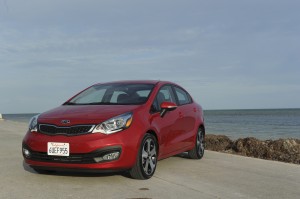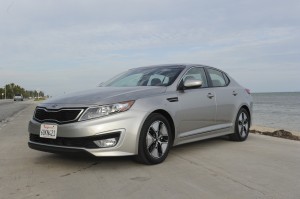 By Barbara & Bill Schaffer
By Barbara & Bill Schaffer
Miami ? We are always up for an automotive challenge, so when Kia e-mailed us the invitation to compete in a hypermiling competition in the new Kia Optima Hybrid, we replied immediately our acceptance and started packing.
This contest had a two-part twist.? In addition to trying to get the highest fuel economy while driving the new Optima Hybrid from Miami to Key West, Florida, we had to find 19 landmarks along the route and take a photo of each. Sounds simple, but it?s not.
We?ve driven the road to Key West previously and knew we should be able to log some impressive fuel economy numbers because of the low speed limits and abundance of law enforcement in the area, which tends to keep the traffic pace slow.
As we often do on these programs, we each teamed up with a friend, so we were competing against each other.? Barbara teamed up with her friend and regular driving partner, Mary.? Together they have won several similar automotive challenges.? Bill drove with Arv, a friend that he often drives with at the new car introductions.
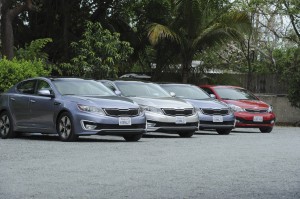 To start with, we like the Kia Optima — the styling, performance and value make it one of the best of a list of impressive mid-size sedans.? That?s something, when you consider their competitors are Camry, Accord, Fusion, Altima and Sonata.
To start with, we like the Kia Optima — the styling, performance and value make it one of the best of a list of impressive mid-size sedans.? That?s something, when you consider their competitors are Camry, Accord, Fusion, Altima and Sonata.
The new Kia Optima Hybrid has the same basic characteristics as the gasoline powered Optimas, but the hybrid technology actually gives it a performance boost over the naturally aspirated versions and better fuel economy, too.
Unlike many other hybrids, Kia/Hyundai engineers developed their own hybrid system rather than partnering with another manufacturer or licensing Prius technology.? The Kia system uses a 40 horsepower electric motor connected by a wet clutch to the efficient 166-hp 2.4-liter four-cylinder Atkinson cycle gas engine.? The power is transmitted to the front wheels by an efficient six-speed automatic transmission.? The pairing results in a smooth, good performing package that achieves a 35 mpg city and 40 mpg highway EPA fuel economy rating plus it accelerates from 0 to 60 mph in 8.4 seconds.
The system uses a 270-volt lithium-polymer battery, which Kia did develop in a partnership with LG Chem.? The battery is about 20-30 percent lighter, and takes up to 40 percent less space than typical nickel metal hydride systems.? The battery also has a 10-year, 150,000-mile warranty.
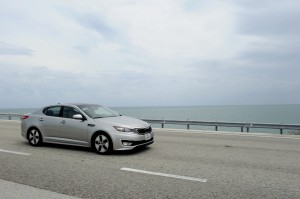 Changes to the headlights, rear spoiler, under floor panels and other parts of the body improved the car?s aerodynamics.? It also uses automatic flaps in the grill to reduce drag by 10 percent over the non-hybrid model, to a very low 0.26 coefficient of drag.
Changes to the headlights, rear spoiler, under floor panels and other parts of the body improved the car?s aerodynamics.? It also uses automatic flaps in the grill to reduce drag by 10 percent over the non-hybrid model, to a very low 0.26 coefficient of drag.
The Kia system uses other features like an air conditioning system with electric compressor and engine ?idle-stop? to maximize the fuel economy numbers.
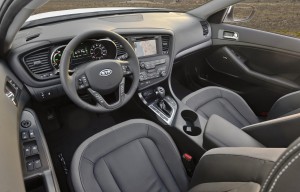 The Kia Hybrid comes in one basic model with two option packages: a $700 convenience package or the Premium Technology package ($5,350) which adds the works, like navigation, rear camera, heated and cooled (front) leather seating, premium audio, panoramic sunroof, HID headlights and a bunch more. ?Pricing starts at $26,450 including the destination charge and can go as high as $32,500 for a fully equipped model.
The Kia Hybrid comes in one basic model with two option packages: a $700 convenience package or the Premium Technology package ($5,350) which adds the works, like navigation, rear camera, heated and cooled (front) leather seating, premium audio, panoramic sunroof, HID headlights and a bunch more. ?Pricing starts at $26,450 including the destination charge and can go as high as $32,500 for a fully equipped model.
In-car connectivity is a big deal now and the Optima Hybrid is the first Kia model to get the new Microsoft? powered voice-activated infotainment system called UVO. ?It is paired with all the audio functions including SiriusXM?.? The system also includes USB input jacks, Bluetooth and a back-up camera.

My driving partner and I placed our main competitive emphasis in getting all the required photos, reasoning that the other competitors might be concentrating on fuel economy numbers and might miss some of the photos.? ??We drove at a normal pace, hoping to take advantage of the new Optima Hybrids excellent mileage.? Because some of the photo targets were a bit tricky, we quickly learned about the solid braking, tight turning radius and agility of this comfortable sedan.
The UVO system was easy to operate and we had no trouble finding our favorite XM Sirius stations to sing-along to, however, agreeing on which one we?d play was another matter ? ?Sinatra, Sinatra, Sinatra, I screamed silently.? ?However, no, we had to listen to a more contemporary station.? I need to try to find an older driving partner who appreciates the ?Rat Pack? music.
One of the neat safety features we discovered was the Virtual Engine Sound System (VESS- No, it?s not another version of the of the VOSS Norwegian water.) ?Because it would be easy to startle a pedestrian when moving silently through a parking lot or similar area, Kia safety engineers created the VESS system, which plays a pre-recorded engine sound during electric-only operation up to 12 miles per hour.? It is designed to help warn people outside the vehicle that it is approaching. ??It worked.? We startled no one while sneaking through parking lots silently in search of one of the photo clues.
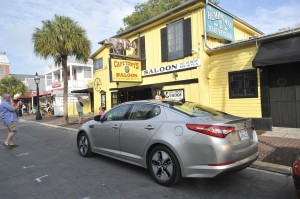 After a while the photo taking challenge became much more demanding than we expected, and when we finished I failed to check the fuel economy numbers, but I?m sure they must have been better than Bill and Arv?s.
After a while the photo taking challenge became much more demanding than we expected, and when we finished I failed to check the fuel economy numbers, but I?m sure they must have been better than Bill and Arv?s.
?
Bill
??????????? My driving partner and I were going for great fuel economy, but without doing all the tricks that might push us over the top.? Real hypermiling competitors use tricks like shutting off the air conditioning and leaving the windows up or folding the side view mirrors back to lower the coefficient of drag even more.? However, with temperatures in the 80s, that can make it very uncomfortable in the car, and we weren?t ready to make that sacrifice.
We were amazed when we looked down at the gauges and saw that we were cruising along, quite often at 50 mpg or more (it?s supposed to go as high as 62 mph) in the electric mode.? The transition was invisible so we had to watch the gauges to know where our power was coming from.
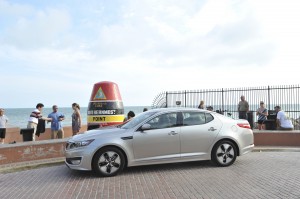 ??? You can definitely feel the regenerative braking while stopping, but we thought the transitions between gasoline and electric were seamless.
??? You can definitely feel the regenerative braking while stopping, but we thought the transitions between gasoline and electric were seamless.
Our main driving technique involved maximizing the use of the electric motor power and keeping our speeds at five to ten miles per hour under the posted speed.? The downside of driving like this is raising the ire of other drivers.? Even though we held back cars on some of the two lane roads into the Florida Keys, we could always see the cars ahead of us, never more than a half mile usually, so we weren?t holding them back any more than the next group of traffic, we reasoned.? That?s hard to explain that to drivers in other cars who want to drive faster, however.? When they had a chance to pass, many of them even waved at us with that special salute.
At Key West, we climbed out the Optima Hybrid with a final mileage of 44.0 mpg.? The winners logged 47.6 mpg.? We were more comfortable and I know we did way better than Barbara and Mary.? However, we were only able to find about 80 percent of the photo locations we needed.
The Optima Hybrid was impressive for its quiet comfort and excellent mileage, but later when it didn?t matter, or the way home we found out that the performance is quite good, too.
??????????? For part of out drive back from Key West to Miami, we drove the new Kia Rio five-door.? It has an EPA fuel economy rating of 31 mpg city and 40 mpg highway.? We enjoyed the spunky performance, and didn?t play like we wanted to get good fuel economy and for the 50 mile leg, we averaged 37.6, but that?s another story for a later time.
? S2403 ? Copyright 2012 by Auto Digest

